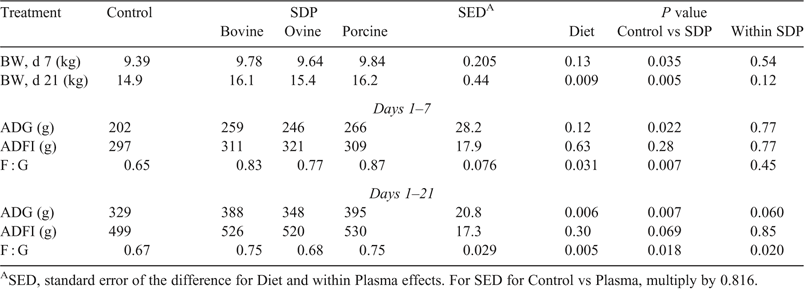Spray-dried porcine and bovine plasma are equally efficacious and superior than ovine plasma when fed to newly weaned pigs
J. J. Cottrell A , A. J. Gabler A , S. C. Grimshaw A , D. J. Cadogan B and F. R. Dunshea A CA The University of Melbourne, Parkville, VIC 3010.
B Feedworks, Lancefield, VIC 3435.
C Corresponding author. Email: fdunshea@unimelb.edu.au
Animal Production Science 55(12) 1544-1544 https://doi.org/10.1071/ANv55n12Ab085
Published: 11 November 2015
Spray-dried plasma (SDP) and similar products have been used by the pig industry for over 20 years to support young pigs prior to and after weaning (Tucker et al. 2011). To date, the comparison of porcine and bovine SDP has shown porcine SDP to produce superior growth performance and lower mortalities after weaning (Torrallardona 2010). However, there are recorded comparisons of ovine SDP with either bovine, porcine or mixed-species plasma in weaner pigs. This experiment tested the hypothesis that porcine, bovine and ovine SDP would be equally efficacious in improving growth performance of weaned pigs.
Sixty individually-housed weaner pigs (Large White × Landrace) with an initial body weight (BW) of 7.96 ± 0.047 kg (mean ± SD) and weaned at 25 days of age were stratified into blocks of four pigs on weaning weight and allocated to a randomised complete block design experiment to examine the effects of diet type on performance in the weaner period. The diets were: a commercial Control weaner diet (Riverina Stockfeeds, Warwick, VIC); Control diet with 5% bovine SDP; Control diet with 5% ovine SDP; and Control diet with 5% porcine SDP replacing other protein sources. Diets comprised 15.4 MJ digestible energy (DE)/kg and 0.92 g standardised ileal digestible lysine/MJ DE. Pigs were fed ad libitum for 21 days with water available on an ad libitum basis. Feed refusals were determined daily and pigs were weighed weekly to determine average daily gain (ADG), average daily feed intake (ADFI) and feed : gain (F : G). Data were analysed by ANOVA (Genstat, 15th Edition; UK) using initial BW as a covariate and contrasts made between control and SDPP as well as within SDPP.
During the first week of the study, SDP increased ADG (202 vs 257 g, P = 0.022) and improved FCE (0.65 vs 0.82, P = 0.007) with no difference between the different SDP sources (Table 1). These responses occurred without any effect on ADFI (P = 0.28). When examined over the 21 day study period, SDP increased ADG (329 vs 377 g, P = 0.007) and FCE (0.67 vs 0.73, P = 0.018). However, there were within SDP effects such that the ADG of pigs fed porcine and bovine SDP had similar ADG which tended (P = 0.060) to be greater than those fed ovine SDP which, in turn, tended (P = 0.060) to be higher than Control-fed pigs. There were also within SDP effects on F : G (P = 0.020) such that the F : G of pigs fed porcine and bovine SDP had the same F : G that were greater than both the pigs fed ovine SDP and the Control pigs. Over the duration of the study, SDP tended to increase ADFI (499 vs 525 g P = 0.069) with no differences between the different SDP. In conclusion, porcine and bovine SDP increased growth performance of weaned pigs in a similar manner whereas the effects of ovine SDP were not as great.

|
References
Torrallardona D (2010) Asian-Australasian Journal of Animal Sciences 23, 131–148.| Crossref | GoogleScholarGoogle Scholar |
Tucker JL, Naranjo VD, Bidner TD, Southern LL (2011) Journal of Animal Science 89, 1466–1473.
| Crossref | GoogleScholarGoogle Scholar |


